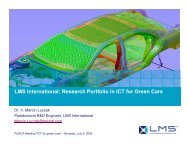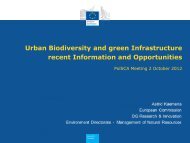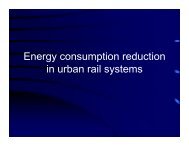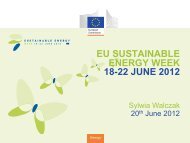Dr hab. Tomasz Grosse - PolSCA
Dr hab. Tomasz Grosse - PolSCA
Dr hab. Tomasz Grosse - PolSCA
- No tags were found...
You also want an ePaper? Increase the reach of your titles
YUMPU automatically turns print PDFs into web optimized ePapers that Google loves.
<strong>Tomasz</strong> Grzegorz <strong>Grosse</strong>Institute of Political Science Polish Academy of ScienceEU Cohesion policy reforms:towards knowledge based cohesionEU Cohesion policy creates a unique opportunity to mobilise the development processes inpoorly-developed agrarian regions, removed from the European economic centres. The mainquestion is not just whether new members from Central and Eastern Europe (CEE) caneffectively absorb the EU funds, but also whether they will be able to channel these funds toinitiatives that will help develop a modern and innovative economy in the regions. In theopinion of specialists 1 current cohesion policy realized in the CEE countries could not havebeen used as an instrument to generate new endogenous potential, i.e. a modern andinnovative economy in peripheral regions. This is related to the domination of infrastructureinvestments and to the marginal importance of investments for R&D, as well as forintroducing new technologies to companies. It is also related to the mechanism of supplantinginvestment for R&D and for developing a modern economy with infrastructure investments,which consume most of the investment provisions available in the public finance systems ofthese countries. The EU Cohesion policy before 2010 was directed too much at improving thelife condition of in<strong>hab</strong>itants and supporting their revenues. It did not sufficiently create longtermimpulses for economic growth. This is related to the risk that Cohesion policy will leadto preserving the dependency of peripheral regions in the CEE States on the redistribution ofpublic funding of social character. In the edge cases, it may be related to creating politicalclientelism and corruption in a way similar to South Italy. This would be related to the processof political parties taking control over EU money transfers for the sake of their own party’sobjectives.International experience indicates that the most efficient method of catching up to the mostdeveloped countries and regions is to initiate development based on innovation and moderntechnologies. Initiation of such a development strategy is, however, a serious challenge in thecase of peripheral regions. It is related to two issues. Firstly, to the construction of anappropriate absorption potential for external aid, in particular the possibilities of efficientadoption of organisational innovations and new technologies in the regional economy.Secondly, the principal problem consists in obtaining a proper "critical mass" of factorsallowing the initiation of automatic generation of innovations and dissemination thereof1 See discussion: T. G. <strong>Grosse</strong> (2010): EU Cohesion policy and the peripheries of the new Member States, in: G. Gorzelak, J.Bachtler, M. Smętkowski (eds.): Regions of Central and Eastern Europe:Development Processes and Policy Challenges,Routledge, Abingdon, Oxford.1
countries and regions of the European Union, promotion of the intellectual capital, climaticand energetic challenges, solving demographic problems, etc.I proposed to re-orient the EU cohesion policy to a greater extent towards objectives ofachieving greater cohesion on the European scale as regards the development of innovativeeconomy. Such an approach extends and re-interprets the Treaty meaning of this policy inrelation to economic, social and territorial cohesion. It places emphasis on innovations, asregards both the construction of innovative economy, innovative society and integratedapproach to territorial development aimed at the introduction of an innovation in a broadsense. It should be strived for the strengthening of proposals put forwards by the Commissionor EU experts that put emphasis on the construction of a new potential for the development ofinnovative economy in underdeveloped regions, in the strategic perspective allowing thedevelopment of research and new technologies, as well as gradual inclusion in the Europeanframework programmes 8 . Such regions should include inter alia stronger support in theseregions for the development of research and science infrastructure, as well as linking it withthe infrastructure of European importance or participating in financial research financed bythe EU budget (e.g. by the European centres of excellence) 9 . A similar recommendation is thedevelopment of cooperative relations that will connect technology platforms that are beingestablished at the regional level with the most competitive and modern European platforms 10 .The proposal of strengthening the regional innovation clusters should also be supported, in thecase of weaker regions for instance in the pilot formula 11 . Efforts should be made in order todiversify strategic resources in the regions (in particular the ones with problems orunderdeveloped ones) and thus to support the construction of a new development potential inthese regions.The division into regions developing on the basis of the paradigm of knowledge-basedeconomy and peripheral regions based on agriculture, raw material economy or cheap labourforce seems to be not beneficial for Europe in the longer perspective. Such cohesion policyconditions perpetuate the mechanisms of dual development in EU. Therefore Europeanmeasures should be oriented towards the objectives of constructing a new endogenouspotential in the peripheral regions to a greater extent.8 Communication from the Commission — Competitive European regions through research and innovation — A contributionto more growth and more and better jobs. Commission of the European Communities, COM(2007) 474 final, SEC(2007)1045, Brussels 16-8-2007, 3-6.9 Guidelines on Coordinating the Research Framework Programme and the Structural Funds to support research anddevelopment, Scientific and Technical Research Committee, CREST 1203/07, Brussels 1 June 2007, 20-21.10 Synergies between the EU 7th Research Framework Programme, the Competitiveness and Innovation FrameworkProgramme and the Structural Funds, European Parliament, PE 385.645, Luxembourg May 2007, 42-43.11 Strategic Evaluation on Innovation and the knowledge based economy in relation to the Structural and Cohesion Funds,for the programming period 2007-2013, Country report: Poland, Technopolis, ISMERI Europa, Merit, Logoteci, Lacave,Allemand & Associes Consultants, July 2006, 41-43.4
















